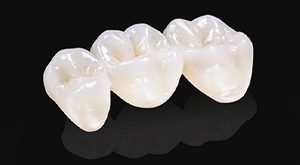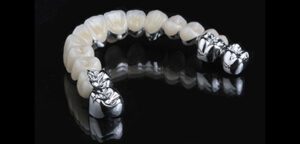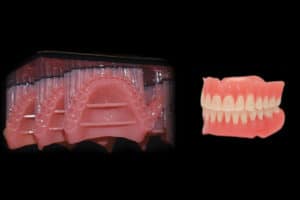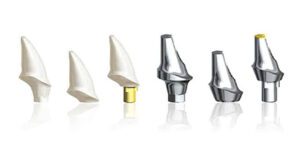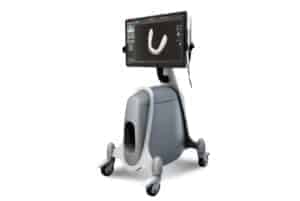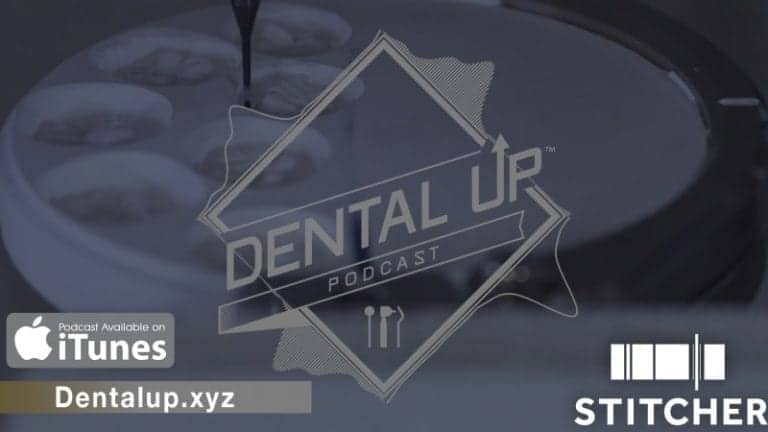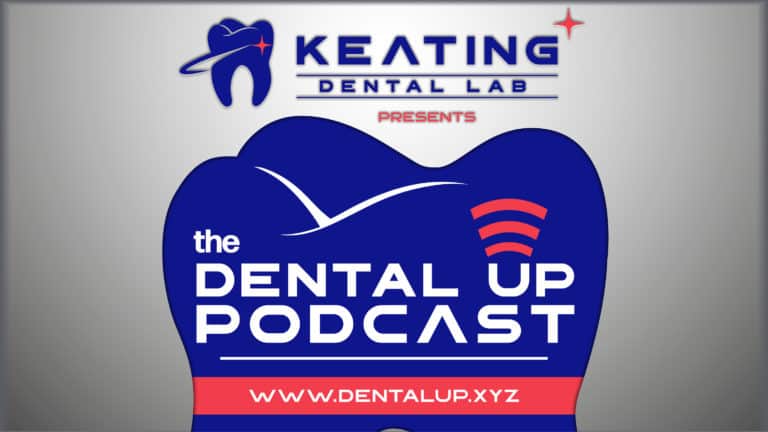With the experience of implementing CAD CAM milling in his two practices, Dr. Peter Patellis DDS, shares indications and contraindications of using chairside milling solutions. Due to the unpredictable results, Dr. Patellis limits the usage of his CAD CAM milling machines, sending anterior and multi-unit cases to Keating for exceptional results. Dr. Patellis prefers to focus on his dentistry rather than creating restorations as it is not in his expertise and explains the importance of keeping debt low by not investing in unnecessary technology when starting a practice.
Full Transcription:
Shaun Keating: Hey everybody. Shaun Keating here. I’d like to welcome you to this week’s Dental Up podcast. This week we have Dr. Pete Patellis and he’s from Kennett Square, Pennsylvania. Pete, how you doing buddy?
Dr. Patellis: I’m doing well, Shaun. Good to see you. It’s been awhile.
Shaun Keating: So good to see you, man. I think last time I saw you was on a rooftop in Vegas. I think it was the Rio or something and you were doing a lecture. I was at that meeting and we hooked up. It was good times, man.
Dr. Patellis: It was. That’s the last time I saw you. It’s been awhile.
Shaun Keating: That was about 40 pounds ago, I’m thinking.
Dr. Patellis: I was going to say, you look good. You’re hair is a little grayer, but that happens to all of us.
Shaun Keating: The hair went white, man. It’s just like all these teeth. I love it, but I went to the mountain, I came down like Moses, man. It’s like, “What the heck?” Well, hey dude, I’d like to start off, let’s talk a little bit about sports. I’m a sports nut. How about you over in the Pittsburgh area? You’re like the quarterback capital of the world. What you got going on your sports end?
Dr. Patellis: Not too much. We’re anxiously awaiting football season, see what happens with the Steelers even though we’re in Eagles country here in Southeast PA. I grew up in Pittsburgh, so it’s in the blood.
Shaun Keating: Oh, yeah. I bet. They’re passionate. I’d like to see the Steelers get back to the old Bradshaw days. It’s just, I grew up in Pittsburgh and it was like the Dallas Cowboys. It’s just Lynn Swann and all that stuff. It just, it’s not like the old days. That’s awesome. I’m a big football guy too. We got some things going on with Angels here. They’re our local baseball team and they’ve lost like I think six games in a row. They haven’t scored in like 20 innings, so it’s disheartening there.
You’ve got the Dodgers, I’m not a real big Dodgers guy. I’m Orange County. Then we’ve got basketball, we’ve got Chicago up, we’ve got Cleveland up two games. I think it’s going to be another Cleveland against Golden State Warriors. I don’t like that Lebron too much. He just says how great he is, like, “Dude, come on, man.” It’s like-
Dr. Patellis: Yeah, he’s not very humble, is he?
Shaun Keating: Yeah. Be humble. You can’t … Every era, it seems like the guy comes on and says, “I’m the greatest.” What about Kareem back in the 70’s and Will Chamberlin and every decade or so, there’s greatness. Now, whenever you’re current, you’re like, “Oh. I’m the greatest of all time.” It’s like, “I don’t know.” He’s still only got like two or three rings. That’s why I want to shut him down so he won’t get that fifth and sixth ring and stuff like that, but I don’t know. He’s kind of a stud, but I like the little splash brothers, the Steph Curry and Clay Thompson. That was a couple young kids and draining those three, man. It was pretty cool.
Dr. Patellis: Yeah, I enjoy watching those guys. I’m not a big NBA fan but if I can catch Golden State, I’ll actually sit down and watch it.
Shaun Keating: Absolutely, absolutely. Well, dude, let’s get into this a little bit now with you. I’ve been with you a long time. How long we been working together probably?
Dr. Patellis: Forever. I think you were still with that other lab when we first started working together.
Shaun Keating: Other lab we don’t want to name, now.
Dr. Patellis: We don’t name any names.
Shaun Keating: Yeah. I don’t want to admit it. No, I have built that, but I built my own little monster here now and I really love it. I love coming in every day. I was just driving in today, man. I’m thinking, “I want to talk with Dr. Patellis.” We go so back. You used to bust my balls when things wouldn’t go right and it was back and forth. We learned a lot together, man, because you’re a real mover and shaker when it comes to dental practice. You’ve got several practices you’ve had. I’ve learned a lot with working with you and stuff, but I was just coming in, I’m looking at my big old building here and I’m like, “Dude, we are so …” It’s just really neat to come in and work every day, and enjoy it. Dude, I want to talk to you a little bit about your practice location. I know you got one in Kennett Square. Then you had one over in like Delaware too, don’t you? Like in Bethlehem or Bethany?
Dr. Patellis: Actually, it’s in Oxford, Pennsylvania just right in between the Delaware and Maryland borders.
Shaun Keating: Okay. What a trip, man. How is it running multiple practices? Is that tough to do, or you do a few days here and there?
Dr. Patellis: I’m in the Oxford office one day a week, got a couple good guys down there working for me. I’m in the Kennett office here three days a week.
Shaun Keating: Oh okay.
Dr. Patellis: It’s not bad, Shaun. It’s like anything else. You’ve got probably 20 times as many employees as I do. Doing the work is easy. Juggling the logistics of the employees is a big thing, but not unlike yourself. If you surround yourself and your business with good people, that takes a lot of the effort off of me so that I can sit and concentrate on what it is that I do best which is dentistry.
Shaun Keating: Absolutely. You do do some great dentistry. I was just talking to Bob out here on the floor and I said, “Hey, I’m talking with Patellis, man.” He’s like, “Ah, you’re kidding. Look at this.” I think we were doing … You’ve been a big CEREC guy. You actually lectured for them and didn’t you do a lot of stuff with CEREC, like a CEREC trainer and all that. I know you’ve done that in the past, but we have this big case. I think we sunk like five implants and just did a regular tissue level impression, I think. You scan that into CEREC and then we did our temps, and now we’re doing the finals. It’s just, it’s all by dang CEREC. It’s kind of crazy. Tell me a little bit about this case and what we’re doing here.
Dr. Patellis: It’s actually my aunt.
Shaun Keating: Oh okay.
Dr. Patellis: Which could be good, could be bad. Basically what we did is, she’s has dental issues her whole life. We originally redid her whole maxilla about 15 years ago for basically just lack of effort on her part. We ended up redoing it again about 8 years ago. This time it was just like, “Look, there’s really nothing more we can do.” We took out the remaining maxillary dentition and we put six implants in and did an immediate load Screw-Retained and let her heal in that, a [inaudible 00:05:54] conversion denture.
She healed in that for about 14 weeks. We took everything off down to the fixture level, and then put in some open train [pressing 00:06:03] copings, and just took standard impression. Then we were able to, we had some preliminary models of the bridge before it came out, before we took the remaining natural dentition out. Bob, who’s actually fantastic, was able to duplicate everything.
You guys made me some custom abutments and a metal reinforced temporary and it was perfect. What we did is we ended up scanning the actually provisional through CEREC and then we took the provisional off and scanned the abutments just like you’re doing a tissue level impression. Then we just scanned the lower arch and we sent it off to you guys. Last time I talked with Bob, the final scan finally came through and it’s in production.
Shaun Keating: Yep, it’s in production.
Dr. Patellis: It’s neat stuff.
Shaun Keating: That is amazing, just the whole digital world. Here I’m talking to you and then Bob shows me this. We just do so much work here, and I’m like, “That’s kind of a cool topic.” I’m not the biggest CEREC guy. CEREC is CEREC and I love it, and my CEREC doctors are probably some of my best guys with coming to margins because you just got to see that, such high mag, but some of my best margins and really good practitioners to get into the CEREC. I’m a lab guy. I make teeth for dentists and now the dentists are doing it, so I’m not totally in love with it but I see what it’s doing for dentistry across the United States and the world, where you can practice and see a patient and a couple hours later, they can leave you. We can also do big stuff like this, full upper, with implants, scan it and there’s no shipping. It’s so freaking accurate.
Dr. Patellis: It’s accurate and that’s … Well, the big thing with anything is digital, Shaun, whether it be CEREC or it be E4D or iTero, it’s not a [inaudible 00:07:46]. It’s not the right modality for every patient. I probably send as many units out to you every month as I’m actually making on CEREC. It’s not like every person that comes in my office that needs a crown done gets a CEREC done because it just doesn’t work that way. I think, at least in my 18 years of being involved with CEREC, is that if you understand what not to do, it serves you well in that there are so many things you can do with it if you understand the four or five scenarios where, “Hey, you know what?” Can and should, “Can I do it with this? Should I do it with this?” I think the biggest thing is if you sit there and you ask yourself, “If I didn’t have this, if I didn’t have a CEREC, would I be using it to do this? Would I be doing it digitally?” If the answer is no, then you shouldn’t do it.
Shaun Keating: It’s probably a time constraint too where-
Dr. Patellis: Absolutely.
Shaun Keating: -it’s going to take me a couple hours to get this guy in and out where I can see three or four patients and snap some impressions, like you’re saying, “Should I or could I do it with this?” Use it that way. I think most doctors probably do.
Dr. Patellis: That’s a great point because I know in our office, if it’s going to take us … Pretty much my limit as far as what I’ll do with CEREC is I’m not doing any anterior teeth, and that’s a personal preference. I just can’t match what you guys do in the lab. The other issue is is I won’t do more than two units in a quadrant just because it’s not time efficient. Like you said, I could sit there and take an impression and send it out to you guys, and it’s prepped, impressed, temporized, so now we’re at 15 minutes. I’m like, “Okay. I might be 3 hours here.” That additional 2 hours and 45 minutes, I could cut 4 more units of crown and bridge.”
Shaun Keating: Absolutely.
Dr. Patellis: You have to be conscious of what’s the money factor involved with [inaudible 00:09:30].
Shaun Keating: Absolutely. Then there’s some guys out there that, I call them the poke and plum towns where you poke your head out the window and you’re plum out of town, and it’s like, “I got nothing else to do. Mabel’s coming in for a crown, and I’m going to do Mabel’s crown at 8 to 10. Then here comes John in,” and I can see it where doctors aren’t real busy and, “I’m going to do everything I can on CEREC.”
It’s just for certain guys. Then as you get milling and you have mismills and some breakage, and you’ve got to do all the glazing, you’re becoming kind of a technician because it’s easier said than done on that CEREC. You’ve got to be pretty sharp just to get the perimeters right, and then when you’re working on the crowns, silly little machines like to do things weird sometimes and certain materials, sometimes there’s a lot more to it, so it’s just-
Dr. Patellis: [crosstalk 00:10:25], yeah.
Shaun Keating: I think it’ll evolve too.
Dr. Patellis: You bring up a great point. Our mantra has always been, when it came to doing anything digitally, was, “I’m a dentist. I don’t want to be a lab tech because I’m never going to be as good as Shaun, I’m never going to be as Bob. That’s what they do and this is what I do.” If I can do something and it’s predictable with CEREC, certainly we do. The last thing I want to have happen with any patients is is that I put something in there and it fails. Then they got to come back and I’m going to send it to you guys anyway.
Shaun Keating: Yeah.
Dr. Patellis: There are circumstances where we plan on doing something in-house and I just tell patients, “Hey, you know what? We’re going to send it out.” Most of them are good about it. The ones that are a little upset about it, I’m just like, “Hey, if the worse thing that happens is that you’re upset with me because it’s going to take us two visits to do that, I can live with that because it’s better for it to be right, I’d rather you be upset with me because it took two visit than upset because it wasn’t right.”
Shaun Keating: Oh absolutely.
Dr. Patellis: I think they’re [inaudible 00:11:16].
Shaun Keating: Yeah. Two visits, that’s the way normally it’s always been in a way and sometimes, there’s three, four, and five visits. I hate to admit that but sometimes, you got silly humans and teeth that like to move. I’ve got oven temps and liquid powder ratios. It’s not a perfect median that we’re in. I just think the whole sanity of it all is we’re trying to get it done right the first time, but at the end of the day, sometimes things happen. To have that bedside manner with the patients … That’s one thing as a lab tech. The models, they don’t feel any pain. I work off stone models every day.
I’m not in that chair when a case is delivered and I don’t have the contact broad enough or something was [inaudible 00:12:03]. You have to deal with those patients, and that’s an art to that to be able to have a thick enough skin, I think, too to where it’s not so much empathy on every patient. It’s a fine line for a dentist that if a case goes right or not, and more so than not, our cases go right, but when they don’t go right, it’s like the lab guy can sit there and go, “Well, I’m sorry about it,” but the dentist has got to feel that.
It’s like I can feel dentists coming through the phones, through the ear sometimes, like, “I want to rip your head off, Shaun. Don’t sit there and say, ‘Ah, I’m really sorry.’ You don’t have this screaming lunatic going, ‘Please, get me out of here! Get my teeth.'” It’s just a lot of patients … I know when I get a crown, I’ve got some posteriors that I’ve been in, and every ten years, I’m breaking them and I’m chewing on rocks and corn nuts and all sorts of stuff. I like getting in and getting that crown in. I have a lab and sometimes he has to adjust it, like, “Why are you touching that crown? I don’t want you to touch it.”
It’s like buying a brand new car and having to smash the bumpers to get it in the garage. That’s why I don’t ever like to try on my crowns and touch them. Take it off the [oppose 00:13:10] and polish that up but there’s nothing like a great crown that goes in with little to no adjustment. Every day our goal is to try to give the best restorations that a doctor doesn’t have to fuss with because you guys got enough issues to worry about to running a practice. The lab should be your least part and when a lab starts becoming 60, 70, 80% of your problem, that’s when you maybe got to start looking for another lab like us over here. We’ll try it.
All right. Hey, so tell me a little bit about when you’re starting off your financing, stuff like that. Was it tough? You had a lot of probably debt from college and starting off. We have a lot of younger dentists. What kind of advice can you give me on just starting off? I know you’ve had multiple practices. What are you at, two, three now, or you’re down to-
Dr. Patellis: We’re at two. We had another one that was actually in Wilmington and unfortunately it fell apart at the settlement table.
Shaun Keating: Really?
Dr. Patellis: Yeah. There was some issues. We’re still looking. I think the best advice that I could give somebody that’s younger and is going to start their own practice is, make a list of what it is you absolutely, 100% need. Be minimalistic. Obviously, you can spend a boat load of money on technology and technology is great. It’s great if it makes what you do easier, if it benefits the patient, and it saves you money. That’s great, but you have to sit there and you have to weight the cost of investing in this technology and taking on the debt as opposed to, “Hey, you know what? There’s another way to do this. I can take a conventional polyether impression and I can send it to the lab. My only payment is for what I did,” as opposed to, “Okay. I’m going to buy a CEREC and hey, my net is $2200 a month whether I do one or I do 50.”
I think that technology is certainly something that as you’re getting into your office, I would say I’m all for technology but I think you should implement technology as you grow and as your patient base expands, and do you have the patient base that is actually interested in that kind of technology? I know that from the Dental Distributor’s standpoint, they’re going to try to sell you a lot of stuff that you really don’t need.
Shaun Keating: Absolutely.
Dr. Patellis: If you have someone that you trust from a dental college standpoint that’s older, sit down and talk to them. Ask them, “Hey, what is it that I absolutely, 100% need? Yeah, I need [inaudible 00:15:33], yes, I need [inaudible 00:15:34], I need [composite 00:15:34], I need impression material. Hey, do I need [inaudible 00:15:37]?” Well, if you’re not placing implants, or you’re not doing a boat load of [inaudible 00:15:42], and you’re not doing orthognathic surgery, what do you need a [inaudible 00:15:46]? You can’t diagnose the [K 00:15:47] on a [inaudible 00:15:48]. There’s too much radiation. That’s why you take bite … I think that the trap with a lot of younger practitioners starting out is that they get used to the technology that was in the office that they were working in. Sure, you want to have that, but you’ve got to sit there and weight the cost versus the benefit.
Shaun Keating: Absolutely. That’s great advice right there, man. Really great advice. Cut your chops first, get in there and do what you can with minimal purchases and then as you grow, yeah, definitely get what’s out there. It’s always best not to buy the first year and make of this car.
Dr. Patellis: The first model.
Shaun Keating: Yeah, we try and stay away from those. I’ve bought those first model years in cars and I learned not to do that anymore. Dude, tell me a little bit about education-wise. I know you’re a big educator. You’ve been educating people across the nation in the dental world, but with you, when you’re starting, what kind of occlusal schemes did you work? Did you go to like … Were you a Pankey guy, a Dawson guy? That’s occlusal things, and what about just getting better in dentistry, too? Have you done any courses like [Acoys 00:16:53]?
Dr. Patellis: About, back in 1999, 2000, Shaun, I went through LVI with Bill [Deckerson 00:16:58] when he was still running the place.
Shaun Keating: Oh okay.
Dr. Patellis: Was a disciple of [Deckersons 00:17:01] until they started to get into the neuromuscular dentistry with the [inaudible 00:17:06] measurement and using the TENS unit. I’m not saying it’s right or wrong. It is a viable modality but I was more of a classic occlusion kind of guy so I went through Dawson. After we finished up Dawson, there was a big interest in my patient census. Their biggest reasons for not getting implants done was they had to go to three or four different places. One place had the implant place, one place had the bone graft done, one place to come back and have it restored. So we actually went through the Misch Institute-
Shaun Keating: Oh Carl, huh?
Dr. Patellis: -back in 2009 and 2010. Basically progressed through that and ended up getting our diplomat status [inaudible 00:17:47] so I’ve been through that with implants. I’ve been on a couple courses with Mike [Pecos 00:17:52], was also great. He’s down on the West Coast of Florida. From a standpoint of continuing education, it’s unGodly expensive. My advice to anybody that’s going to look into bettering themselves is that, make certain that you get quality continuing education. There’s a lot of guys out there that are fly-by-night. A lot of solid institutions, [Corey’s 00:18:16] is a great one.
A good friend of mine up in Huntington Bay, Long Island is going through [Corey’s 00:18:22] right now. Obviously, if you’re going to go and again, just my opinion, if you’re going to go and learn to place implants, the Misch Institute is without question the finest institute world. There are other venues that you can go to once you cut your chops placing implants like [Pecos 00:18:40], [Pecos 00:18:41] in [Salama 00:18:42]. I know they do a lot of good things together. My standpoint, learning the nuts and bolts about what to do and more importantly what not to do-
Shaun Keating: Not to do, yeah.
Dr. Patellis: -when placing implants, you definitely need to go to Misch. You want to start to learn to do a case like we did with my aunt. They cover that a lot in the latter classes that are available at the Misch Institute. Stuff like that is also covered with Mike [Pecos 00:19:06] down in Florida. Whatever you do, it’s going to be expensive wherever you go, and the big thing, if you’re going to go through a continuing like [Pecos 00:19:14] or Misch, it is a commitment both financially and time wise.
Shaun Keating: Oh it is.
Dr. Patellis: I know it took us about nine months to go through the continuing with Misch and from that point forward, it was about another six to eight months just gathering cases that I’d previously done before I went through Misch to go along and get our diplomat status through the [inaudible 00:19:36].
Shaun Keating: That’s awesome. To be able to sink your own implants like you do and as accurate as you do, I didn’t know you went to Misch. What about, do you know Randy Resnik, Randolph Resnik there?
Dr. Patellis: Randy? Randy and I went to school together.
Shaun Keating: Oh, you’re kidding?
Dr. Patellis: We’ve known each other a long time. He taught me everything I know.
Shaun Keating: Can you believe, I did his work for years and years, and we did it here too. I think they’re in cahoots with another lab we don’t want to name, but Randy is a great guy. For years, I did, we were just PFM’s with him and then it’s evolved. He really became the implant guy and I think he’s taking over. Carl passed away and God rest his soul, for sure.
Dr. Patellis: Yeah. I believe that’s the case. I talked to, I was down in New Orleans with him for the [ICY 00:20:21] meeting in February. That’s the first time I’d seen him in awhile, but we probably talk a couple times a month. Randy is Randy. He’s a great guy.
Shaun Keating: Yeah.
Dr. Patellis: A good friend. Like I said, we go back a long ways. We were both in school. We’d have to pull our money together to get enough money to get a pizza and a beer, so that’s how far back we go.
Shaun Keating: That is so cool. What a small world. I didn’t know you guys were together like that. I’ve known him since the 80’s, early 90’s. It was always Randolph Resnik because that’s what went on our lab script, it would say and, “Shaun. Randy, call me Randy.” No, that’s so cool. What a small world. Dude, what about, tell me a little experience about working with my lab. Good or bad, what do you think about us? How we doing on the-
Dr. Patellis: You guys are awesome Shaun. We were just talking this morning, my staff. We had to send something locally, [inaudible 00:21:12], “Okay I need this back in a day.” Long story short, it didn’t show up. I had to call them to find out where it was. I told my staff, I said, “The best thing about working with Shaun and Bob is is I always know what’s going on.” I understand stuff happens in the labs like, “Hey, we have a miscast. Hey, this didn’t pass QC.” Stuff happens, but I never have to call you guys to find out what’s going on with a case.
It’s like, “Hey, this doesn’t look right, didn’t pass QC. I’m not sending it out. It’s going to be an extra day.” You guys do awesome work. That goes without saying. We’ve been doing business together a long time, and like you said, there’s a lot of other places out there, they’re not as good as you guys, but you and I have been through thick and thin together.
Shaun Keating: Absolutely.
Dr. Patellis: The best attribute aside from the quality work that you guys do is that there’s never a doubt in my mind when you say a case is going to be back, it’s going to be back. If it’s not going to be back, you’re not calling me the day it’s due back to tell me it’s not going to be here. You’re always giving me a couple of days. Communication aspect, throughout the whole lab, I normally end up talking to Serena on the phone. It’s like we’ve got a personal relationship. I don’t even have to tell her who I am anymore. She just hears the voice. You’ve got a good crew, Shaun. I don’t know how many people you’ve got working there, but the people that I’ve dealt with personally, they are top notch.
Shaun Keating: That’s so cool, dude. Thank you so much. I do, I’m so blessed to have these guys and very thankful. Like I always say, you’re always as good as your people, no matter what kind of business you’re in. Take care of your people and it’ll come back to you. It just really does. It’s not me, it’s the people and we just, we love what we do making teeth, man. It’s kind of a neat thing that you still keep that passion every day. I love seeing it and I love hearing, just talk to you and, “Oh, we’ve got his [hands 00:22:55] case in here and it’s a big ole freaking upper that you sunk all the implants.”
We did it by the book. It wasn’t like a, “Let’s just knock this out. Boom.” We did it from the temporaries to scanning that, to just the whole thing from [inaudible 00:23:11] to temps to the finals are now coming around the horn, down the final stretch. It’s very predictable dentistry when you work together hand in hand with the dentists in the lab. It’s the best way to do it. I like the seat of the pants a little bit here and there with some cases.
Johnny came in on Monday and we’re going to prep and we’re going to see them on Tuesday, and it works. It’s not … Some guys will pick it apart a little bit here and there, but dentistry is dentistry. A lot of guys got to think about it too much sometimes, and they’re holding back on certain cases thinking, “Should I do it?” Especially if it’s a relative. I always think a relative is better because hopefully they’re not going to sue you or nothing.
Dr. Patellis: They’re not paying for it anyway.
Shaun Keating: Yeah, they’re not paying for it, so they’re the best kind of customers. Man, that’s so neat. Dude, what else can you tell me about the future of dentistry? What do you think? I know we talked a little bit about digital, but you think with impression taking, that’s going to take more of a, just the future of dentistry and the competition and the lack of insurance in certain areas? What do you see in the horizon as we’re winding down our careers as we’ve been in it for awhile, but what do you think the future of dentistry holds from Peter Patellis here?
Dr. Patellis: Well, I think that technology is certainly going to continue to play a role in dentistry, Shaun. Having said that, there are always going to be people that are just going to be more comfortable taking an impression. One of the guys that works for me down in the Oxford office is just, he’s like, “I’m just not comfortable [dating 00:24:51] a digital scan.” He goes, “Do you care if I take an impression?” I’m like, “It doesn’t matter. The end product is what matters, not how you get there.”
I think that implants are going to continue to be a very robust portion of dentistry. If I were going to sit there with a young doctor coming out of school or someone that is just getting going and they ask me, “Hey, what should I start to think about,” I would start thinking about going to Misch and learning to place your own implants. Part of the reason for that is that there’s always been this mystique that placing implants is a surgical specialty.
Implants is a restorative aspect of dentistry with a surgical subset. Nobody comes into my office telling me they want implants. They come into my office telling me, “I want teeth.” Implants are the modality and I know that a lot of the times with surgeons or periodontists placing the implants, a lot of stuff gets lost in communication where it’s like, when we do the implants, we figure out, “What do we want to do here restoratively?” The restorative treatment plan dictates the number of implants and where they’re placed as opposed to you send them to the surgeon like, “Oh, hey. I can get it to integrate back here as I go.” It’s like, “Well, I can’t put a tooth there.”
Shaun Keating: Exactly.
Dr. Patellis: So what good is the implant? I think that the future of dentistry is very [inaudible 00:26:29] white. The advice that I would give to young dentists is to commit. Commit yourself to doing excellent dentistry, excellent continuing education, get yourself a good staff, even if it’s a small staff. My staff here in Kennett, they are … It took me 25 years to get an absolutely fantastic staff. My girls here … Perfect example. I’m leaving tomorrow to go away for four days, tomorrow morning, and I won’t worry about one thing in this office because if there’s an emergency, it’ll be handled.
If there’s something that needs to be shipped out, it’ll be handled. When I come back to work here on Monday morning, it’ll be like I wasn’t gone at all. That’s the best thing about my staff is obviously, they’re great people and they do great work but I can leave my office and I can have peace of mind which in this day and age is very difficult to put a price on.
Shaun Keating: Oh, it definitely is. That is just so on the money right there. I think there’s a lot of dentists out there that would like to get it to that point where when they leave, they’re worried and they have to be on the phones and all this. Just like me, when I leave here, it is dialed in and it is taken care of. It’s just something, I sleep easy. It’s just a beautiful thing to have that. Well, Dr. Patellis, I want to thank you for coming in. I know it’s lunchtime and we got to get you back, but I want to thank you so much for this. I want to thank you for all the work through all the years, man. We really, really appreciate it. If there’s anything I can ever do, let me know, for sure.
Dr. Patellis: Well, you guys have been awesome with me Shaun. You guys have always treated me fairly. Like I said, we go back a long way. We don’t see each other a whole hell of a lot, but we always talk on the phone. You guys have been great, and I truly appreciate everything you and Bob, and everyone at Keating Dental Lab has done for us.
Shaun Keating: Oh, thank you.
Dr. Patellis: One last bit of advice for these young guys that are out there coming out of school starting their own practice, just like you and I did when we were there. Chase the dream, not the money.
Shaun Keating: That’s it. Chase the dream, not the money. Love it, dude. Well, hey. Thanks again, Pete. I will talk to you soon Dr. Patellis. Everyone here at Keating Dental Lab wants to thank you for this week and listening in. If you could, subscribe on iTunes on the Dental Up podcast and leave a review. If any of you doctors want to come onboard, just email us [email protected]. I want to thank you again, Dr. Pete Patellis from Kennett Square, Pennsylvania. You’re the man. You’re a good looking guy, too, man. Looking good.
Dr. Patellis: I’m not near as good looking as you.
Shaun Keating: Oh, dude.
Dr. Patellis: I’ve got to get that [inaudible 00:29:15].
Shaun Keating: I’m looking at that hair. We’ve got to do something. I’m [inaudible 00:29:19]. I’m coming bald next time, look like Howard Farran. All right, dude.
Dr. Patellis: All right, brother. I’ve got to rock here, man. Thanks so much. I appreciate it, Shaun.
Shaun Keating: Thanks a lot dude. Later on, man. Bye bye.
Dr. Patellis: Yeah. Peace. Love you. Be good.
Shaun Keating: Love you too.

